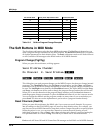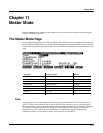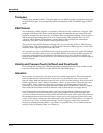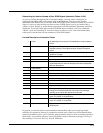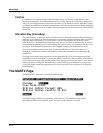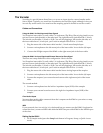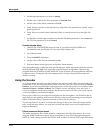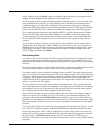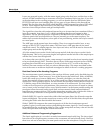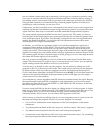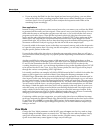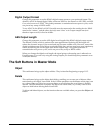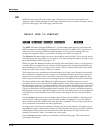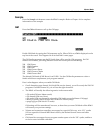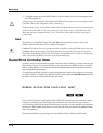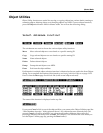
11-8
Master Mode
The MAST2 Page
Layers are grouped in pairs, with the master signal going to the first layer, and the slave to the
second. All odd numbered layers are master and all even numbered layers are slave. If you look
at the algorithms in the vocoding programs, you will see that the first two DSP blocks (after
PITCH) of each layer are a bandpass filter (or low pass or hi pass filters for the first and last
bands). The first layer then has a DSP called MASTER, while the second layer has a DSP called
SLAVE. These stages are then followed by an AMP stage. These DSP blocks perform the
function of an envelope follower and gain multiplication.
The signal flows from the odd numbered (master) layer to its associated even numbered (Slave)
layer (for example, from layer 1 to 2), which is something that does not happen in other
algorithms. The low pass frequencies controlled by the third time slot for each layer set the
response speed of the envelope follower. They are normally set to the same frequency. The
master layer controls the frequency of one pole of low pass filtering, and the slave layer controls
two more poles.
The AMP page on the master layer does nothing. There is no output from this layer, so any
settings on the OUTPUT page don't matter. The slave layer's AMP page does do an actual
amplitude control. The output pages for slave layers are active, and can be used to choose the
output group and set the step panning.
All of the master layers use the LiveIn Left keymap and all of the slave layers use the LiveIn
Right keymap. That is why you must plug the microphone into the left side of the sample input
and the slave source into the right side.
As is always the case with Live mode, a note message is required in order for an incoming signal
to be processed through VAST. Therefore, the two layers in the setup assigned to the vocoding
programs have Pswitch2 set to generate a C4 with a velocity of 127, as soon as the setup is
selected. That note remains on until you select a different setup. The setups are edited so that
none of the notes on an 88 note keyboard are assigned to either of the two vocoding programs
Real-time Control of the Vocoding Programs
The most important control parameter is the envelope follower speed, set by the third time slot
low pass parameters. These are set to C 6 on all the layers for the initial level. Slider A (MIDI 6)
lowers the cutoff up to 8 octaves (9600 cents). Therefore, the higher you raise the slider, the
slower the envelope follower speed. C 6, as a filter cutoff, has a time constant on the order of one
millisecond. This is generally too fast. For best results, this should be lowered about 4 octaves to
C 2 (half the range of the Data Slider), to a time constant of 16 milliseconds. Too slow and the
vocoder will not respond to quick transients, like consonants, and too fast will result in a jittery
sort of sound, as the envelopes follow every little fluctuation. At the fastest possible setting, the
envelopes follow the master audio signal itself, and an extremely harsh intermodulation is
heard between master and slave. The vocoder setups have an entry value of 64 for this slider, so
when the setup is selected it is the equivalent of having the slider halfway up.
Slider B (MIDI 12) is used to control the width of the band pass filters (for all bands except the
lowest and highest). The vocoder setups have an entry value of 10 for this slider, the equivalent
of having the slider at the first dot above the bottom.
Slider C (MIDI 13) transposes the center frequencies of all the slave bandpasses upward
together. It gives you the same result as pitch shifting the master signal up. Vocal formants will
be munchkinized as you bring the slider up. The vocoder setups have an entry value of 0 for this
slider, the equivalent of having the slider at the bottom.
Additional Notes and Programming Suggestions
The classic application of a vocoder is to make instrumental sounds talk/sing. The slave signal
has to have a lot of high frequency content, or the consonants will not be heard clearly. However,
there is no rule set in stone that you must speak words into the microphone. Using the vocoder



